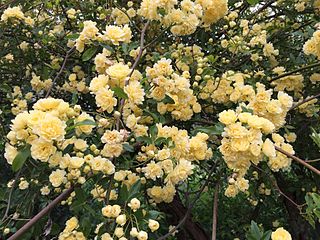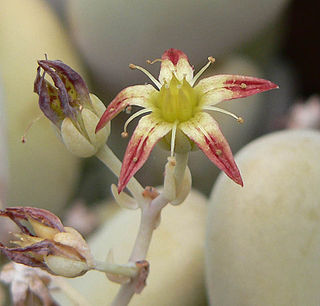
A rose is either a woody perennial flowering plant of the genus Rosa, in the family Rosaceae, or the flower it bears. There are over three hundred species and tens of thousands of cultivars. They form a group of plants that can be erect shrubs, climbing, or trailing, with stems that are often armed with sharp prickles. Their flowers vary in size and shape and are usually large and showy, in colours ranging from white through yellows and reds. Most species are native to Asia, with smaller numbers native to Europe, North America, and northwestern Africa. Species, cultivars and hybrids are all widely grown for their beauty and often are fragrant. Roses have acquired cultural significance in many societies. Rose plants range in size from compact, miniature roses, to climbers that can reach seven meters in height. Different species hybridize easily, and this has been used in the development of the wide range of garden roses.

Rosa multiflora — is a species of rose known commonly as multiflora rose, baby rose, Japanese rose, many-flowered rose, seven-sisters rose, Eijitsu rose and rambler rose. It is native to eastern Asia, in China, Japan, and Korea. It should not be confused with Rosa rugosa, which is also known as "Japanese rose", or with polyantha roses which are garden cultivars derived from hybrids of R. multiflora. It was introduced to North America, where it is regarded as an invasive species.

Echeveria is a large genus of flowering plants in the family Crassulaceae, native to semi-desert areas of Central America, Mexico and northwestern South America.

Rosa gallica, the Gallic rose, French rose, or rose of Provins, is a species of flowering plant in the rose family, native to southern and central Europe eastwards to Turkey and the Caucasus. Rosa gallica was one of the first species of rose to be cultivated in central Europe. It is a parent of several important cultivars.

In 1984, the International Organization for Succulent Plant Study set up a working party, now called the International Cactaceae Systematics Group, to produce a consensus classification of the cactus family, down to the level of genus. Their classification has been used as the basis for systems published since the mid-1990s. Treatments in the 21st century have generally divided the family into around 125–130 genera and 1,400–1,500 species, which are then arranged in a number of tribes and subfamilies. However, subsequent molecular phylogenetic studies have shown that a very high proportion of the higher taxa are not monophyletic, i.e. they do not contain all of the descendants of a common ancestor. As of August 2023, the internal classification of the family Cactaceae remained uncertain and subject to change. A classification incorporating many of the insights from the molecular studies was produced by Nyffeler and Eggli in 2010.

Selenicereus, sometimes known as moonlight cactus, is a genus of epiphytic, lithophytic, and terrestrial cacti, found in Mexico, Central America, the Caribbean and northern South America. The term night-blooming cereus is also sometimes used, but this is also used for many night-blooming cacti, including Epiphyllum and Peniocereus. In 2017, the genus Hylocereus was brought into synonymy with Selenicereus. A number of species of Selenicereus produce fruit that is eaten. The fruit, known as pitaya or pitahaya in Spanish or as dragon fruit, may be collected from the wild or the plants may be cultivated.

Rosa banksiae, common names Lady Banks' rose, or just Banks' rose, is a species of flowering plant in the rose family, native to central and western China, in the provinces of Gansu, Guizhou, Henan, Hubei, Jiangsu, Sichuan and Yunnan, at altitudes of 500–2,200 m (1,640–7,218 ft). The rose is named for Dorothea Lady Banks, the wife of the botanist Sir Joseph Banks.

Rosa chinensis, known commonly as the China rose, Chinese rose, or Bengal rose, is a member of the genus Rosa native to Southwest China in Guizhou, Hubei, and Sichuan Provinces. The first publication of Rosa chinensis was in 1768 by Nikolaus Joseph von Jacquin in Observationum Botanicarum, 3, p. 7 & plate 55.

Dudleya abramsiisubsp. setchellii, known by common name as the Santa Clara Valley dudleya or Santa Clara Valley liveforever, is a member of the Dudleya genus of succulent perennials, members of the family Crassulaceae. The Santa Clara Valley dudleya, endemic to the Santa Clara Valley region in the southern San Francisco Bay Area, was listed on 3 February 1995, as an endangered species. It is considered to be a subspecies of Dudleya abramsii, but its taxonomic status is still unclear. Its closest relative is Dudleya cymosa subsp. paniculata, which is a morphologically similar sister taxon.

Graptopetalum amethystinum, also called jewel-leaf plant, is a plant belonging to the succulent genus Graptopetalum. It is native to Mexico.

Echeveria runyonii is a species of flowering plant in the family Crassulaceae, that is native to the state of Tamaulipas in Mexico. Several cultivars have been described and cultivated.

Graptopetalum bartramii is a species of succulent plant known as Bartram's stonecrop and Patagonia Mountain leatherpetal.

Rosa × odorata or Rosa odorata is a hybrid flowering plant of the genus Rosa native to Yunnan in southwest China, whose taxonomy has been confused. It has been considered a hybrid of Rosa gigantea and Rosa chinensis, or as a quite rare wild species that includes R. gigantea. The wild forms are cultivated to some extent. Cultivars were developed in China in ancient times from R. chinensis crosses, and these have been important in the ancestry of the tea-scented China roses, also called tea roses, and their descendants the hybrid tea roses.
Vera Higgins (1892-1968) was a British botanist, author, translator and botanical illustrator known for being an authority on succulents and cacti, particularly Crassulaceae. She graduated from Cambridge University and worked at the National Physical Laboratory. Higgins was the first editor of The Cactus Journal of the Cactus & Succulent Society of Great Britain, beginning in 1931 and continuing until 1939 when the Society closed because of World War II. She then edited the Journal of the Royal Horticultural Society between 1939 - 1945. She was elected a fellow of the Linnean Society of London in 1945 and was awarded the Royal Horticultural Society Victoria Medal of Honour in 1946.

Echeveria pulvinata, the plush plant, is a species of flowering plant in the genus Echeveria, native to southwest and central Mexico. A succulent, it has gained the Royal Horticultural Society's Award of Garden Merit. Its variety Echeveria pulvinata var. leucotricha, under the synonym Echeveria leucotricha, the chenille plant, has also gained the Award of Garden Merit.

Kimnachia is a monotypic genus of cacti. Its only species is Kimnachia ramulosa, synonym Pseudorhipsalis ramulosa, which is native from southern Mexico to northern South America and also found in Jamaica.
Reidmorania occidentalis is a succulent plant in the stonecrop family (Crassulaceae) native to the state of Sinaloa in Mexico. It is within the monotypic genus Reidmorania, which is named after botanist Reid Moran, who was notable for his research in the Crassulaceae family.















